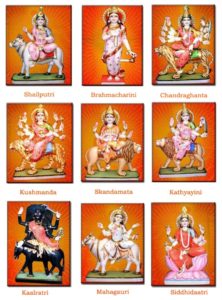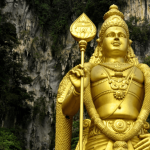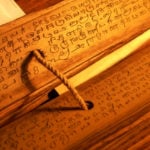
Durga and Navaratri
Navaratri festival is fast approaching, and the Hindus worldwide are getting ready to celebrate it according to their culture and traditions. Navratri is one of India’s India’s grand festivals observed with pomp and devotion for nine nights and ten days. According to the Hindu Customs, four different Navratris celebrated every year. Amongst the four, the Chaitra Navratri falling in March/April and the Sharad Navratri observed during September/ October are more popular. This year Sarada Navaratri starts on October 7 and ends on October 15. India is a vast country with different traditions and customs, which influence how a festival is observed. Navaratri too is celebrated differently in various parts of India, and there are many parallel legends associated with the festival. A wide belief regarding the festival’s origins is that during Navaratri, Goddess Durga slew Mahishasur, the buffalo-headed demon, and saved the world from his evil clutches. Ramayana, too, is associated with Navaratri, as in some parts of the country, people believe that it was on the day of Dashami, Lord Ram killed Ravan after nine days of the war.Nava Durga, the Nine forms of Durga
Goddess Parvathi is worshipped in several forms all over the country; she is known in different names and depicts various attributes. Durga is a form of Mother Parvathi, and her worship is popular amongst the devotees. In many parts of India, Navaratri is referred to as ”Durga Pooja”. During the nine days of Navaratri, devotees of Mother Durga observe fast and worship the nine manifestations or forms of Goddess Durga, popularly known as Nava Durga. Each day of Navaratri has a special significance, and one form of the Goddess Durga is worshipped. Each day is also associated with one color and one planetary body. The below table contains the names of the Navadurgas and the color and the planetary body associated with them.
The below table contains the names of the Navadurgas and the color and the planetary body associated with them.
| Form of the Goddess | Day of Worship in Navaratri | Signifying Planet | Favourite Colour |
| Shailputri | 1st day | Moon | Orange |
| Brahmacharini | 2nd day | Mars | White |
| Chandraghanta | 3rd day | Venus | Red |
| Kushmanda | 4th day | Sun | Royal blue |
| Skandamata | 5th day | Mercury | Yellow |
| Katyayani | 6th day | Jupiter | Green |
| Kalaratri | 7th day | Saturn | Grey |
| Mahagauri | 8th day | Rahu | Purple |
| Siddhidatri | 9th day | Ketu | Peacock green |
The first day is ideal to worship Shailaputri. Goddess Parvati is the daughter of Himalaya, the Mountain. In Sanskrit, Shail means the Mountain, and thus she is hailed as Shailputri, the daughter of the Mountain. In this form, the Goddess rides a bull and carries a trident in her right hand and a lotus flower in her left hand.
Day 2:On Dwitiya, the second day of Navaratri, the Goddess is worshipped as Brahmacharini, the spinster. The Goddess adopted this form when she did penance towards Lord Shiva to attain him as her husband. In the Brahmacharini form, the Goddess walks bare feet and has a Japa mala and a kamandalu in her hands.
Day 3:Goddess Chandraghanta is worshipped on the third day of Navaratri. After marrying Lord Shiva, the Goddess got this name as she started adorning half Chandra (moon) on her forehead. In this form, the Goddess is seen riding a tiger and has ten hands holding various weapons.
Day 4:On the fourth day of Navaratri, Devi is worshipped in the form of Kushmanda. She is the reason behind the existence of the Universe and all its creations. Mother Kushmanda has a lion as her mount and features eight hands that hold various weapons.
Day 5:Goddess Skandamata is worshipped during the Panchami thithi of the Navaratri period. The Goddess in this form is the mother of Skanda, also known as Lord Kartikeya. The Goddess featuring four hands holds the infant Kartikeya with her and rides a ferocious lion.
Day 6:Devi Katyayini is invoked on the Shasthi thithi. She is the warrior goddess and is one of the ferocious forms of Goddess Parvati. The Goddess is hailed in this name as she was born to Rishi (sage) Katya. Katyayini Devi has four hands and is seen riding a Lion.
Day 7:Maha Saptami, the seventh day of Navaratri, is ideal for the worship of Devi Kalaratri. She is the most ferocious form of Goddess Parvati and was the one who slew demons Shumbha and Nishumbha. She features a dark complexion, rides a donkey, and has four hands.
Day 8:The eight-day of Navaratri is known as Maha Ashtami and is ideal for the worship of Mata Mahagauri. The Goddess features a fair complexion and rides a bull, and has four hands.
Day 9:The last day of the Navaratri festival is known as Maha Navami, and on this day, devotees offer their prayers and respects to Goddess Siddhidaatri. The mother is seated on a lotus and bestows all types of Siddhis to devotees.
« Secrets of Maha Navaratri: Fall 9 Nights of the Goddess What Is Pradosham & Its Significance »

